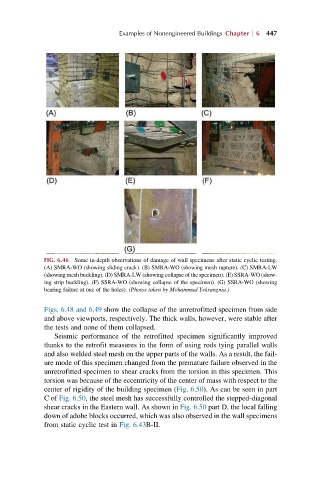Page 504 - Advanced Design Examples of Seismic Retrofit of Structures
P. 504
Examples of Nonengineered Buildings Chapter 6 447
FIG. 6.46 Some in-depth observations of damage of wall specimens after static cyclic testing.
(A) SMRA-WO (showing sliding crack). (B) SMRA-WO (showing mesh rupture). (C) SMRA-LW
(showing mesh buckling). (D) SMRA-LW (showing collapse of the specimen). (E) SSRA-WO (show-
ing strip buckling). (F) SSRA-WO (showing collapse of the specimen). (G) SSRA-WO (showing
bearing failure at one of the holes). (Photos taken by Mohammad Yekrangnia.)
Figs. 6.48 and 6.49 show the collapse of the unretrofitted specimen from side
and above viewports, respectively. The thick walls, however, were stable after
the tests and none of them collapsed.
Seismic performance of the retrofitted specimen significantly improved
thanks to the retrofit measures in the form of using rods tying parallel walls
and also welded steel mesh on the upper parts of the walls. As a result, the fail-
ure mode of this specimen changed from the premature failure observed in the
unretrofitted specimen to shear cracks from the torsion in this specimen. This
torsion was because of the eccentricity of the center of mass with respect to the
center of rigidity of the building specimen (Fig. 6.50). As can be seen in part
Cof Fig. 6.50, the steel mesh has successfully controlled the stepped-diagonal
shear cracks in the Eastern wall. As shown in Fig. 6.50 part D, the local falling
down of adobe blocks occurred, which was also observed in the wall specimens
from static cyclic test in Fig. 6.43B-II.

